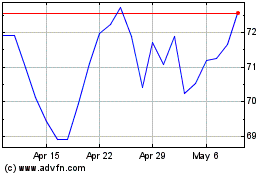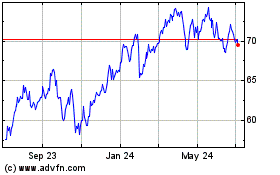AIG, Prudential Make Pitch to Regulators on 'Living Wills'
January 15 2016 - 3:40PM
Dow Jones News
American International Group Inc. and Prudential Financial Inc.
said they would extensively restructure their businesses if they
came under severe financial stress, their latest pitch to convince
regulators that they have credible plans for avoiding taxpayer help
if they were to fail.
The public versions of the firms' 2015 "living wills" were
released Friday by the Federal Reserve. They are the firms' second
attempt to show the Fed they have credible plans to go through
bankruptcy without assistance—a test they must meet because they
have been designated "systemically important financial
institutions," or SIFIs, under the 2010 Dodd-Frank law.
Firms that fail to provide credible living wills can be broken
up by regulators or face restrictions on their business. MetLife
Inc., the third U.S. insurance firm designated as a SIFI, will
submit its first plan before the end of 2016.
The filings come amid pressure on the insurance firms to
reconsider their size given the "living will" requirements and
other stricter regulations that come with being a SIFI. MetLife on
Tuesday said it was divesting large parts of us U.S. life insurance
business in part as a result of the tougher rules, putting pressure
on its rivals to consider similar moves.
The latest plans from AIG and Prudential provided more detail
than they did last year—a response to orders by regulators. The
firms file both private and public versions of the plans. Private
versions can run tens of thousands of pages, but last year AIG and
Prudential's public plans were 16 and 33 pages, respectively.
AIG's new, 43-page public plan released Friday contains a
lengthier description of how it would unwind all its material legal
entities; its previous version contained just a few paragraphs.
AIG's plan contemplates a scenario under which it could cease to
exist, even in smaller form, by liquidating or selling off its
businesses. If possible, AIG said it would seek to reorganize
property-casualty insurance units so that they could continue to
operate as going concerns, saving jobs and minimizing disruption to
the economy as a whole. Otherwise, those operations would be sold
or spun off in initial public offerings or large asset sales.
Its parent company and some of its noninsurance operations would
be liquidated under a chapter 11 bankruptcy-court plan. Its
life-insurance businesses would be placed into state receivership
proceedings, where they would ultimately be liquidated.
AIG's plan also details the dramatic way it has shrunk in size
and riskiness since 2008, when the then-sprawling insurance and
financial-services conglomerate nearly collapsed and became a
government ward with one of the largest bailouts, at nearly $185
billion at its peak. The bailout was fully repaid by the end of
2012.
AIG noted that since 2007, it has "materially decreased" its
total assets by 53%, to $502 billion from $1.06 trillion; decreased
total debt by 83% to $31 billion from $176 billion, and increased
shareholders' equity 3% to $99 billion from $96 billion, among
other moves. AIG has narrowed its focus to insurance after
divesting aircraft leasing and most of the derivatives and other
financial products that contributed to its 2008 problems.
Prudential, the second largest U.S. life insurer by assets
behind MetLife, offered a 58-page plan under which its assets would
shrink by about 60%.
It would put its U.S. insurance companies under rehabilitation
proceedings run by state regulators, envisioning that they would
emerge as operating companies.
If necessary to raise money during a bankruptcy, its parent
company would sell certain businesses and reorganize around the
ones that it retained, emerging from bankruptcy a leaner entity.
While the plan doesn't specify what businesses would be sold, it
says asset-management businesses "would be the most likely."
After reading the two firms' first living-will plans last year,
the Fed said they hadn't adequately addressed certain obstacles to
failing without taxpayer help and ordered them to "demonstrate that
they are making significant progress" this time around.
That was a worrisome verdict for the firms, but the regulators'
language was less severe than their rebuke to 11 large banks in
August 2014. Those banks refiled their plans last year and are
still awaiting a response from regulators, which is expected next
month at the earliest.
Write to Ryan Tracy at ryan.tracy@wsj.com and Leslie Scism at
leslie.scism@wsj.com
(END) Dow Jones Newswires
January 15, 2016 15:25 ET (20:25 GMT)
Copyright (c) 2016 Dow Jones & Company, Inc.
MetLife (NYSE:MET)
Historical Stock Chart
From Mar 2024 to Apr 2024

MetLife (NYSE:MET)
Historical Stock Chart
From Apr 2023 to Apr 2024
